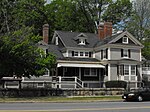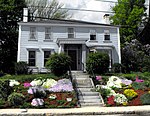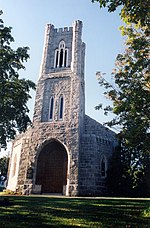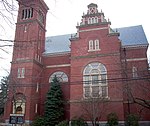Henry Preston House
Essex County, Massachusetts Registered Historic Place stubsHouses in Methuen, MassachusettsHouses on the National Register of Historic Places in Essex County, MassachusettsNational Register of Historic Places in Methuen, Massachusetts

The Henry Preston House is a historic house in Methuen, Massachusetts. Built around 1840, the house was originally built as a one-story house belonging to Henry Preston who had a wheelwright shop next door. Assessor's records indicate that in the 1850s, the house belonged to Enoch A. Merrill, and in 1875 the estate of Enoch A. Merrill was taxed to Joel Foster. The barn, which still exists, appears of the map between 1872 and 1884. Foster, who owned other farm sites in Methuen, was named the leading farmer in Essex County in 1884.It was added to the National Register of Historic Places as the House at 15–19 Park Street in 1984.
Excerpt from the Wikipedia article Henry Preston House (License: CC BY-SA 3.0, Authors, Images).Henry Preston House
Ditson Place, Methuen
Geographical coordinates (GPS) Address Nearby Places Show on map
Geographical coordinates (GPS)
| Latitude | Longitude |
|---|---|
| N 42.727222222222 ° | E -71.184722222222 ° |
Address
Ditson Place 16
01841 Methuen
Massachusetts, United States
Open on Google Maps











